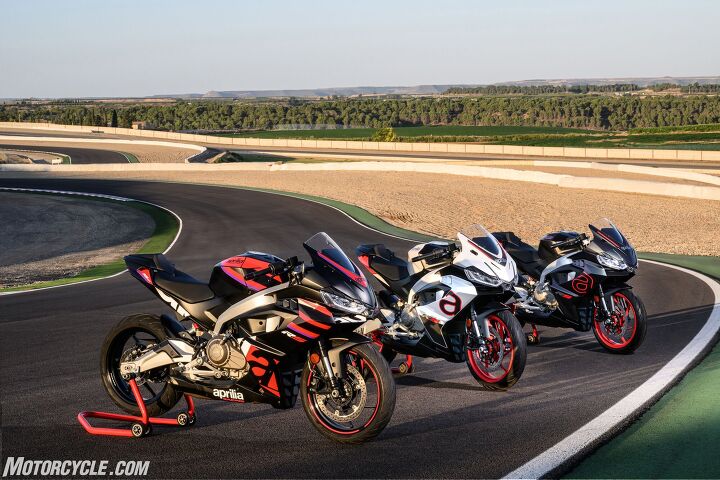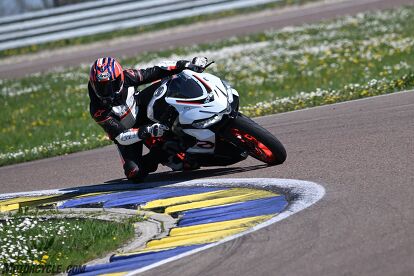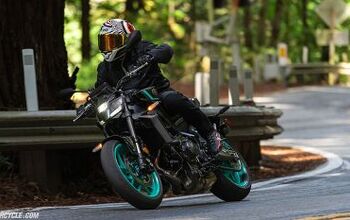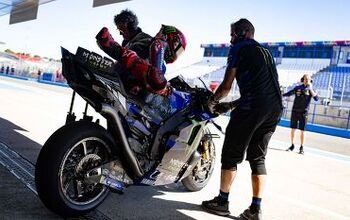2024 Aprilia RS457 Review – First Ride

A refreshing gateway drug into the world of Aprilia
Picture it: you’re a new or newer sport rider who aspires to own an Aprilia. You could go with the RSV4, which you ultimately want to graduate to eventually, but it’s a terrible idea to get one right off the bat. The RS660 could be a decent choice, depending on your abilities, comfort level, and talent. But that’s probably a bad idea, too. What are you to do? Over in Europe and Asia they have the RS125, but we don’t get that bike over here. Your options, it seems, would be to look elsewhere and fulfill your Aprilia dreams later – until now.
2024 Aprilia RS457
Apriila's entry-level sportbike opens the gates for newer riders to join the Aprilia family without committing to an RSV4, or even an RS660. But "entry-level" certainly doesn't mean cheap or boring.
Reviewer's Score: 83%
Engine | 17.5/20 | Suspension | 12/15 | Transmission | 8.5/10 |
Brakes | 7/10 | Instruments | 5/5 | Ergonomics | 7/10 |
Appearance | 10/10 | Desirability | 9/10 | Value | 7/10 |
Highs
- Aprilia knows how to make a good chassis
- Best sounding engine in the class – and it goes pretty good, too
- Also, it's the best looking bike in the class
Sighs
- Cramped cockpit for track riding
- Brakes are a master cylinder away from being top notch
- Kinda pricey compared to most of the competition
With the new RS457, Aprilia has filled a gap in its product line. In the US, it’s the entryway for newer, younger riders to join the Aprilia family, while in other markets it’s the next logical (and in some cases, legal) step after the RS125 to graduate through the tiered licensing system. In this way, the RS457 is truly a global model.
Step Into The World Of Aprilia
Style is important no matter the bike, but especially so for lightweight bikes aimed at the budding rider. Shouldn’t they want to covet what could possibly be their first motorcycle (or first new motorcycle)? Every time they hop off the bike, they should look back at it and like what they see. Only recently have models in this segment started to look appealing. Fortunately, if there’s one thing Italians know how to do, it’s making good-looking motorcycles. With the RS457, we basically have a miniature RS660 – and that’s not a bad thing. The signature Aprilia RS face is instantly recognizable, and as you move around the 457 you’ll notice influences of the 660, and even the RSV4, along the fairings, frame, and beyond. It’s very slim and compact.
More intricate details of the 457’s styling include the dedicated vents and extractors throughout the nose and side fairings, designed to move hot air down and around the rider. Wind tunnel testing and CFD modeling were used to ensure very little warm air moves up toward the rider. Speaking of the rider, they sit in a relatively comfortable position. Aprilia didn’t mention the models they benchmarked by name, but instead overlaid rider triangles of the 457 alongside two other models color-coded in green and orange. Compared to the Kawasaki Ninja 400, the Aprilia’s 31.5-inch seat height is slightly taller, but still lower than the KTM RC390’s. The Aprilia’s pegs are a little further back than the other two (and are rubber-mounted), but surprisingly, all three have bar positions that are relatively similar.
What this amounts to is a motorcycle that not only is attractive, but is also still user-friendly. My 5-foot, 8-inch frame fit comfortably on the bike, and my 30-inch inseam had no issues flat-footing both feet at the same time. I’ll discuss comfort while riding in just a moment.
Powering the RS457 is a new engine and is not just an RS660 engine sleeved down. That much would be very obvious were you to put the two engines side by side. With a 69mm bore and 61.1mm stroke, the liquid-cooled, DOHC, 457cc Parallel-Twin features four valves per cylinder and a 270-degree firing order, which ensures a different soundtrack its competitors can’t match. Something else the competition can’t match, at least according to Aprilia, is the power-to-weight ratio. Making a claimed 47.6 horsepower at 9,400 rpm and 32 lb-ft of torque (80% of which is available at 3,000 rpm), Aprilia says those horses are only pushing around a wet weight of 385 lbs (175kg). That’s certainly an impressive amount of power and an impressive lack of weight for the class.
We expected Aprilia to equip this bike with a potent engine, but it might be more impressive that it incorporated its signature handling know-how into the chassis. In fact, the engine (crankcase, specifically) is a central stressed member by which the swingarm is attached to, just like with the RS660. Up front, it’s attached to an aluminum frame – the only aluminum frame in the class – to help with the lightweight theme and provide the right amount of chassis feedback. Up front there’s a 41mm fork with preload adjustability only and 4.7 inches of travel. The rear shock also gets preload adjustment only and has 5.1 inches of travel. Neither of these components are branded, and it seems Aprilia deliberately doesn’t mention the manufacturer, but they appear to be KYB pieces.
With a bike so light, making only a modest amount of power, in Aprilia’s eyes braking duties can be handled by a single 320mm semi-floating disc. In fact, Aprilia stated this reduction to only a single brake disc results in 15% less gyroscopic forces compared to a twin disc setup. A four-piston ByBre radial-mount caliper squeezes the disc, and it’s fed fluid through a steel-braided line and axial master cylinder.
You don’t normally associate learner bikes with tech, but that’s where the RS457 stands out from its competitors. With three levels of traction control (1, 2, and off) and two levels of ABS (level 2 engages both wheels, level 1 is front ABS only), these are features the rest of the class don’t have (and arguably don’t need). But the pièce de résistance is the 5-inch TFT display providing all of the bike’s information. Put it all together and it’s an impressive bit of kit for a bike costing $6,699 - $6,899, depending on color. How did Aprilia manage to keep the price so low? You likely know the answer: shipping the manufacturing overseas. The RS457 is made in India.
Riding Impressions
Sometimes there’s an “a-ha!” moment when evaluating motorcycles where everything comes together and the purpose of a motorcycle becomes crystal clear. This moment came to me while hustling the RS457 around the tight and twisty Autodromo di Modena. The curvaceous nature of the track means you’re changing direction from left to right or vice versa in quick succession, basically for the entire lap. A small, lightweight, and sure-footed bike is critical. The RS457 is all of those things. Flicking the bike from tight right and then to tight left – and then back again – through the Modena circuit’s infield omega section was effortless, requiring just a small tug on the bars as I shifted my weight from one side to the other. Then at full lean, the chassis felt stable and sure-footed in that classic Aprilia style we’ve been used to since riding the RSV4.
Credit for this goes to the chassis, which was easily the biggest surprise. Other bikes in this category, save for KTM’s RC390, aren’t particularly known for their race-inspired chassis. Dealing with flex and the associated insecurities that come with it when you’re trying to ride fast are just part of the deal with sportbikes in the entry-level or small displacement category. As mentioned, the RC390 shucks that trend with a nice chassis of its own, but is severely let down by a weak engine. The RS457 balances a superb chassis with an engine to keep even veteran riders entertained – all while not being overwhelming for those with less experience.
The RS457 keeps up the fun factor, despite only having 47.5 horsepower, by having a redline of 10,700 rpm. What’s more, 80% of its 32.1 lb-ft of torque is available by 3,000 rpm. That’s a huge rev range of usable power to play with, and because the 270º firing order sounds great (and unlike anything else in the class) even with a stock exhaust, there’s tons of motivation to twist that throttle to the stop as often as possible.
What sets the RS457 apart from the competition is its electronics package. While I generally agree having traction control and ABS on a 47 hp motorcycle seems a little silly on a sunny day, when the riding conditions are bad, all bets are off and I’d take all the assistance I can get. This is especially true if we’re talking about new or newer riders facing adverse riding conditions. The 457’s R-b-W throttle is a little on the light side, so it takes a second to adapt the wrist to the light throttle pull. Because of this, the bike can feel a little jerky in the first two gears, especially in Sport mode, until you calibrate your brain. It’s not an issue after you adjust.
That said, I was pleasantly surprised with Eco mode. Initial throttle response is noticeably muted compared to Sport, but you don’t lose any of the power. Ultimately, this means you can take it to wide open throttle earlier with considerably less fear of spinning the rear tire. Even if you don’t take this bike to the track, Eco mode can be a good alternative to Sport for city commuting and traffic hopping.
The wide rev range and usable torque meant I could carry gears longer than I might on the competing models, and though 32 lb-ft of torque is not a lot by any means, the engine is able to pull out of slow speed corners without the need to downshift into first gear. That’s despite the fact that gearing feels a little tall. If it were mine, adding two teeth to the rear sprocket would be one of my first changes. Of course, having the optional bi-directional quickshifter installed on our test bike is nice, but it works best in track situations where the revs are high before you shift. The few shifts I did in lower speeds were characteristically abrupt for a track-focused quickshifter. Luckily, the clutch pull is light enough that shifting on your own shouldn’t be much of a chore.
There are two levels of ABS and three levels of traction control, with 1 being least intrusive and 3 being the most. All three power modes are correlated to the different traction control settings, but ABS level 2 (most intrusive) is the default setting for all the modes. Simple taps of the down arrow on the (backlit) left switchgear can lower or disable TC if you want, and similar long presses of the mode button can switch ABS to level 1, where only the front ABS is activated. You can’t turn ABS off entirely.
Negatives
Downsides to the RS457? Yeah, I have a few. First is the body position. At least in regards to track riding. In a tuck, I prefer to have my elbows in front of my knees, not beside them. Doing this requires scooting back in the seat. With the RS, I have to move up and over the passenger seat cowl. An unnatural and uncomfortable position, at best. To be fair, this is an issue on a lot of sportbikes, not just the RS. The seating position seems comfortable-ish for everyday street riding, and I’m impressed by the narrowness of the waistline, allowing my 30-inch inseam to flat foot both feet at the same time.
Next is the brakes. The addition of steel-braided brake lines is always a good thing, but attaching them to a cheap axial master cylinder almost defeats the purpose. Our test bikes were equipped with optional “racing” brake pads that add extra bite over the stock pads, making the actual stopping power pretty impressive. The problem lies at the point of maximum braking, as you’re squeezing the lever as hard as you dare, but the feedback at the lever is squishy and soft – as if you had rubber brake lines. It’s difficult to gauge exactly how much braking force you’re giving when you reach the point of threshold braking – unless you reach the point where ABS kicks in. To Aprilia’s credit, the ABS engagement point was a lot deeper than systems I’ve tried on other bikes.
When I think back to the intended customer, however, I realize I’m getting way ahead of myself. Riders who may not have the experience and are learning the ropes will absolutely benefit from a braking system that won’t toss them on their head the moment they touch the brake lever. The RS457 will give the rider plenty of room to grow as they develop their overall skills in all manners of riding quickly, including braking. Hell, it even reminded me to progressively load the brakes to still reach maximum braking, but without any ABS intervention whatsoever.
Lastly, there’s the price. Starting at $6,799 for the Prismatic Dark and Opalescent White colorways, and moving to $6,899 for the Racing Stripes livery, the RS457 is considerably more expensive than every bike in its class except for the $7299 Honda CBR500R. Now, I only place it in the negatives category because it’s way more than the next closest competitor, the Kawasaki Ninja 500, which starts at $5,299, but I do also realize you’re getting more features on the Aprilia for the added cost.
What about the suspension, you ask? Other than feeling some weight transfer as I applied power or brakes, the suspension faded into the background. It feels sprung slightly stiffer than other entry-level bikes in this class, but not overly so. Ultimately, it was supportive where it needed to be and gave decent feedback. That’s about all you can ask of a budget suspension. We did add a turn of preload into the shock to bring the rear up slightly (a net positive in terms of handling, I might add), but otherwise there wasn’t much to say. Now, those sentiments can – and likely will – change once we get the bike Stateside and can experience their compliance over our notoriously bumpy roads and racetracks.
Is This The New Entry-Level King?
It would be easy to hand over the crown in the entry level sportbike market to Aprilia right now, but I’m going to stop short of naming the RS457 the King of the hill just yet. Rest assured, it's really impressive for the class. There’s a fun and playful engine that’ll satisfy riders of all levels mated to a chassis that has no business being this good. Those two things alone rank it pretty high already, but throw in the electronics and the style points, and you have a bike I could only dream of owning when I was getting started in this sport. Not that we think you should buy a new motorcycle as your first bike, but if you did go down that road, this would be a good one. Bikes will be available in US dealers starting in June 2024.
Clearly, all that’s left to do now is gather up the competition to settle the score once and for all. It seems like we say this every year, but this truly is a good time to be a motorcyclist.
In Gear

- Helmet: Arai Corsair-X Vinales
- Leathers: Alpinestars GP Force Chaser
- Airbag: REV’IT! Avertum Tech-Air
- Gloves: Racer High Racer
- Boots: Alpinestars Supertech R
2024 Aprilia RS457 Specifications | |
|---|---|
Type | Liquid-cooled, parallel-Twin, 8-valve, DOHC, 270° Firing order |
Capacity | 457cc |
Bore | 2.72” (69.0mm) |
Stroke | 2.41” (61.1mm) |
Compression | 10.5:1 |
Maximum Power | 47.6 HP at 9,400 rpm |
Maximum Torque | 32.5 LB-FT @ 6,700 rpm |
Fuel System | Electronic injection with 1 injector per cylinder and 2 motorized 36mm throttle bodies (ride-by-wire) with fixed-length intake trumpets. 1 dynamic air intake. Selectable multimap. |
Exhaust | Stainless steel 2 into 1 header system with low single sided stainless steel silencer |
Final Drive | 520 Chain |
Clutch | Wet, multi-plate, slip & assist |
Gearbox | 6 speed |
Frame | Aluminum |
Swingarm | Twin-sided, steel |
Front Wheel | Cast aluminum alloy 5 spoke, 17 x 3.0 in |
Rear Wheel | Cast aluminum alloy 5 spoke, 17 x 4.5 in |
Front Tire | 110/70 ZR 17 |
Rear Tire | 150/60 ZR 17 |
Front Suspension | Preload adjustable upside-down hydraulic fork with 41 mm (1.61 in) stanchions. 4.72 in (120mm) travel |
Rear Suspension | Shock absorber adjustable for spring preload. 5.1 in (130mm) travel |
Front Brakes | Single 320mm semi-floating disc, 4 piston ByBre radial caliper, ABS |
Rear Brakes | Single 220mm fixed disc, two-piston ByBre caliper, ABS |
Instruments | Multi-function instruments with color 5" TFT screen |
Length | 77.2” (1960mm) |
Width (Handlebars) | 31.3" (795mm) |
Height (to top fairing) | 44.9” (1140mm) |
Seat Height | 31.5” (800mm) |
Wheelbase | 53.2 “ (1350mm) |
Rake | 24.1° |
Trail | 4.0 inches (102.5mm) |
Wet weight | 388lbs (176kg) |
Fuel Tank Capacity | 3.43gal (13 liters) |
Fuel Consumption | 57.4 mpg (claimed) |
CO2 Figures | 93 g/km |
Emissions Standard | EURO 5+ |
Service interval | 3,500-mile oil changes, 10,000-mile valve adjustment, air filter, spark plug replacement |
We are committed to finding, researching, and recommending the best products. We earn commissions from purchases you make using the retail links in our product reviews. Learn more about how this works.
Become a Motorcycle.com insider. Get the latest motorcycle news first by subscribing to our newsletter here.

Troy's been riding motorcycles and writing about them since 2006, getting his start at Rider Magazine. From there, he moved to Sport Rider Magazine before finally landing at Motorcycle.com in 2011. A lifelong gearhead who didn't fully immerse himself in motorcycles until his teenage years, Troy's interests have always been in technology, performance, and going fast. Naturally, racing was the perfect avenue to combine all three. Troy has been racing nearly as long as he's been riding and has competed at the AMA national level. He's also won multiple club races throughout the country, culminating in a Utah Sport Bike Association championship in 2011. He has been invited as a guest instructor for the Yamaha Champions Riding School, and when he's not out riding, he's either wrenching on bikes or watching MotoGP.
More by Troy Siahaan










































































































Comments
Join the conversation
I can't see anybody with more sense than money buying an Italian vehicle.
Actually, one could expand that thought, change "Italian" to "European".
Cost, availability, reliability, longevity, And then there is the stigma of ignorance attached to ownership. People know you are ignorant without you saying a thing.